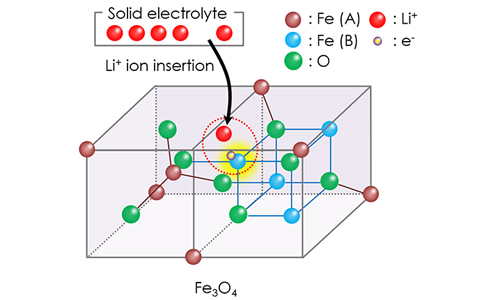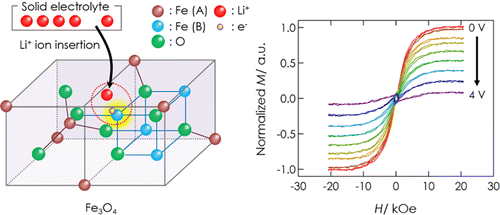R&D: Tuning Magnetic Properties for Better Storage
High-density data storage and spintronic devices achieved by reversibly controlling electrical and magnetic properties of thin films
This is a Press Release edited by StorageNewsletter.com on December 15, 2016 at 2:49 pmFrom: The International Center for Materials Nanoarchitectonics, NIMS
High-density data storage and spintronic devices could be achieved by reversibly controlling electrical and magnetic properties of thin films.
Schematic showing the chemical basis for a novel redox device
that has been made by WPI-MANA researchers.
The electrical and magnetic properties of the device can be
adjusted and reversed by adding or removing lithium ions (LI+)
from a layer of magnetite (Fe3O4).

The ever-increasing amounts of electronic data that we generate in our personal and professional lives require new storage technologies that can fit lots of data into small physical spaces. The most promising solutions include solid-state redox devices, which work by controlling the magnetic properties of materials. By carefully adjusting the chemical composition of ferromagnetic thin films, researchers succeeded in tuning reversible magnetic properties, which can be applied to next-generation high density data storage enabling low power consumption.
Tsuchiya, Terabe, and Aono at the International Center for Materials Nanoarchitectonics, NIMS and co-workers have developed a new solid-state device in which several magnetic and electrical properties can be changed and reversed by inserting and removing ions. The team believes that their device could pave the way for spintronics – novel devices that exploit not only the charges on electrons but also the intrinsic angular momentum, or spin, that is predicted by quantum mechanics.
The new device contains a thin film made from the iron oxide magnetite (Fe3O4) next to a layer of lithium silicate. Magnetite holds particular interest for spintronics, because it is predicted to be a half-metal, meaning that it conducts only electrons of one particular spin state. When the researchers apply voltages across certain parts of their device, they can insert or remove lithium ions into the magnetite, thereby changing the electrical conductivity, magnetization, and magnetoresistance (the dependence of electrical resistance on an external magnetic field) of the thin film.
Article : In Situ Tuning of Magnetization and Magnetoresistance
ACS Nano has published an article written by Takashi Tsuchiya, International Center for Materials Nanoarchitechtonics (WPI-MANA), National Institute for Materials Science (NIMS),1-1 Namiki, Tsukuba, Ibaraki 305-0044, Japan, and Department of Applied Physics, Faculty of Science, Tokyo University of Science, 6-3-1, Niijuku, Katsushika-ku, Tokyo 125-8585, Japan, Kazuya Terabe, International Center for Materials Nanoarchitechtonics (WPI-MANA), National Institute for Materials Science (NIMS),1-1 Namiki, Tsukuba, Ibaraki 305-0044, Japan, Masanori Ochi, Tohru Higuchi, Department of Applied Physics, Faculty of Science, Tokyo University of Science, 6-3-1, Niijuku, Katsushika-ku, Tokyo 125-8585, Japan, Minoru Osada, Yoshiyuki Yamashita, International Center for Materials Nanoarchitechtonics (WPI-MANA), National Institute for Materials Science (NIMS),1-1 Namiki, Tsukuba, Ibaraki 305-0044, Japan, Shigenori Ueda, Quantum Beam Unit, National Institute for Materials Science (NIMS), 1-2-1 Sengen, Tsukuba, Ibaraki 305-0047, Japan, and Synchrotron X-ray Station at SPring-8, National Institute for Materials Science, 1-1-1 Kouto, Sayo, Hyogo 679-5148, Japan, and Masakazu Aono, International Center for Materials Nanoarchitechtonics (WPI-MANA), National Institute for Materials Science (NIMS),1-1 Namiki, Tsukuba, Ibaraki 305-0044, Japan.

Abstract : “An all-solid-state redox device composed of Fe3O4 thin film and Li+ ion conducting solid electrolyte was fabricated for use in tuning magnetization and magnetoresistance (MR), which are key factors in the creation of high-density magnetic storage devices. Electrical conductivity, magnetization, and MR were reversibly tuned by Li+ insertion and removal. Tuning of the various Fe3O4 thin film properties was achieved by donation of an electron to the Fe3+ ions. This technique should lead to the development of spintronics devices based on the reversible switching of magnetization and spin polarization (P). It should also improve the performance of conventional magnetic random access memory (MRAM) devices in which the ON/OFF ratio has been limited to a small value due to a decrease in P near the tunnel barrier.“
Copyright © 2016 American Chemical Society












 Subscribe to our free daily newsletter
Subscribe to our free daily newsletter
